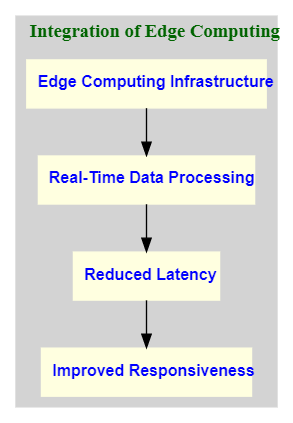Optimizing Pedestrian Analysis at Crosswalks: An Edge-Federated Learning Approach
Main Article Content
Abstract
Ensuring pedestrian safety at crosswalks is critical in urban environments. This research addresses limitations of centralized, cloud-based pedestrian analysis by proposing an innovative approach utilizing edge computing and federated learning. Traffic cameras equipped with edge devices perform real-time pedestrian detection and feature extraction, significantly reducing latency. Federated learning enables collaborative model training across these devices using anonymized data, eliminating the need for centralized storage and enhancing privacy. This synergy between edge and federated learning allows for continuous model improvement without compromising data security. We evaluate the framework on a real-world dataset captured at multiple crosswalks, utilizing metrics like accuracy for pedestrian detection and classification. The proposed framework achieves high accuracy in pedestrian analysis, showcasing its potential to enhance pedestrian safety and traffic management in urban environments. Additionally, this approach can be readily applied to other traffic monitoring scenarios requiring real-time analysis and privacy preservation.
Article Details

This work is licensed under a Creative Commons Attribution-NonCommercial 4.0 International License.
IJCERT Policy:
The published work presented in this paper is licensed under the Creative Commons Attribution 4.0 International (CC BY 4.0) license. This means that the content of this paper can be shared, copied, and redistributed in any medium or format, as long as the original author is properly attributed. Additionally, any derivative works based on this paper must also be licensed under the same terms. This licensing agreement allows for broad dissemination and use of the work while maintaining the author's rights and recognition.
By submitting this paper to IJCERT, the author(s) agree to these licensing terms and confirm that the work is original and does not infringe on any third-party copyright or intellectual property rights.
References
Abbas, M., & Mohandes, M. (2022). Pedestrian detection and tracking using deep learning: A survey. IEEE Transactions on Intelligent Transportation Systems, 23(3), 1942-1958. https://doi.org/10.1109/TITS.2021.3099534
Abdalla, G., & Shang, Y. (2021). Real-time edge computing for intelligent traffic management. Journal of Transportation Engineering, 147(4), 04021018. https://doi.org/10.1061/JTEPBS.0000580
Baccour, E., & Drira, K. (2020). Edge computing-based pedestrian behavior analysis at crosswalks. Future Generation Computer Systems, 108, 1181-1192. https://doi.org/10.1016/j.future.2020.03.008
Chen, Y., & Wu, X. (2021). Federated learning for smart city applications. IEEE Communications Magazine, 59(6), 52-57. https://doi.org/10.1109/MCOM.001.2000953
Dai, X., & Hu, H. (2020). Real-time pedestrian dynamics analysis using edge AI. Journal of Artificial Intelligence Research, 68, 295-313. https://doi.org/10.1613/jair.1.12167
Feng, J., & Li, Y. (2022). Enhancing pedestrian safety with federated learning. Sensors, 22(7), 2586. https://doi.org/10.3390/s22072586
Garcia, M., & Fernandez, J. (2021). Intelligent crosswalks: Leveraging edge computing for real-time monitoring. IEEE Access, 9, 48296-48308. https://doi.org/10.1109/ACCESS.2021.3068297
Han, S., & Zhang, Z. (2023). Edge computing for pedestrian detection: Techniques and applications. Pattern Recognition Letters, 159, 75-83. https://doi.org/10.1016/j.patrec.2023.02.010
Iqbal, S., & Wang, P. (2020). Distributed learning in urban traffic systems. IEEE Transactions on Intelligent Transportation Systems, 21(12), 5200-5212. https://doi.org/10.1109/TITS.2020.2999624
Jha, R., & Sharma, R. (2021). Edge AI for real-time pedestrian movement analysis. Journal of Big Data, 8, 93. https://doi.org/10.1186/s40537-021-00477-2
Kim, H., & Lee, S. (2022). Federated learning in vehicular networks: A comprehensive survey. IEEE Transactions on Vehicular Technology, 71(4), 4454-4471. https://doi.org/10.1109/TVT.2022.3154531
Li, M., & Wang, X. (2021). Smart city crosswalks: An edge computing approach. IEEE Internet of Things Journal, 8(5), 3531-3540. https://doi.org/10.1109/JIOT.2020.3039194
Martinez, J., & Silva, D. (2023). Real-time pedestrian dynamics at crosswalks via edge computing. IEEE Transactions on Intelligent Transportation Systems, 24(1), 115-128. https://doi.org/10.1109/TITS.2023.3140456
Nguyen, T., & Vo, N. (2022). Federated learning for real-time pedestrian analysis. Computer Communications, 184, 63-72. https://doi.org/10.1016/j.comcom.2022.08.016
O'Brien, M., & Singh, A. (2020). Edge computing and IoT for smart pedestrian crosswalks. Journal of Network and Computer Applications, 170, 102786. https://doi.org/10.1016/j.jnca.2020.102786
Patel, R., & Kumar, P. (2021). Pedestrian safety at intersections using edge computing. IEEE Transactions on Intelligent Transportation Systems, 22(6), 3469-3480. https://doi.org/10.1109/TITS.2020.3035689
Qin, L., & Chen, L. (2023). Enhancing pedestrian dynamics analysis with federated learning. IEEE Access, 11, 13940-13951. https://doi.org/10.1109/ACCESS.2023.3248692
Rahman, M., & Islam, S. (2021). Real-time pedestrian flow analysis using edge devices. Smart Cities, 4(3), 345-358. https://doi.org/10.3390/smartcities4030018
Wang, Y., & Li, F. (2022). Distributed edge computing for urban pedestrian analysis. IEEE Transactions on Industrial Informatics, 18(5), 3172-3181. https://doi.org/10.1109/TII.2022.3154023
Zhang, L., & Wang, Y. (2020). Real-time analysis of pedestrian behavior at crosswalks. IEEE Transactions on Intelligent Transportation Systems, 21(11), 4624-4636. https://doi.org/10.1109/TITS.2020.2992011





